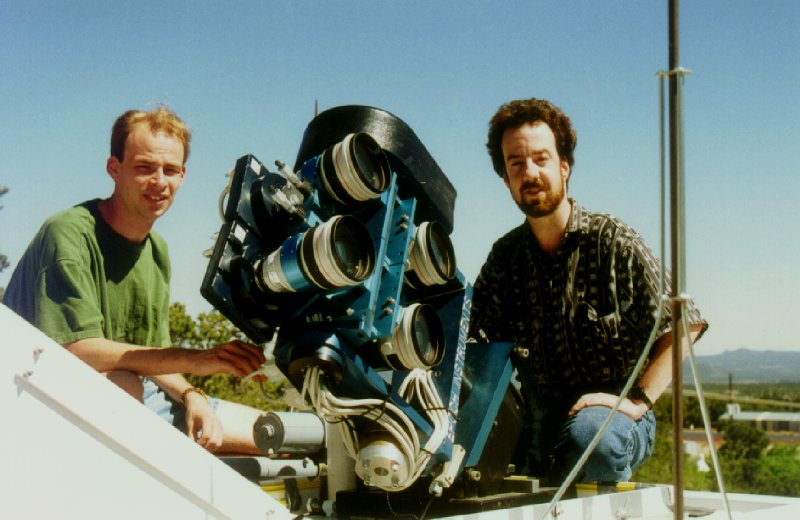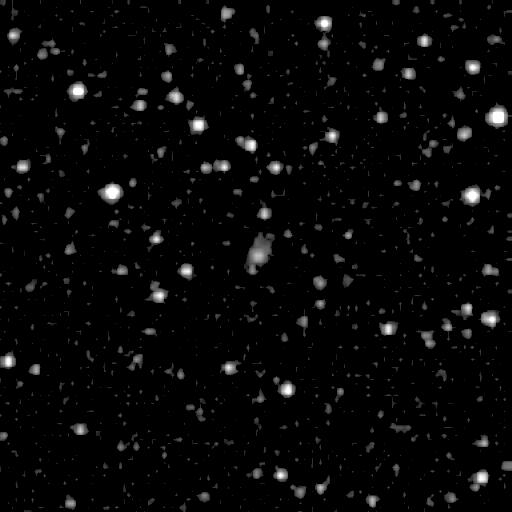AAS press release, June 9, 1998
![]()
FOR RELEASE: 10:00 am PDT, June 9, 1998
NEW ROBOTIC CAMERA FINDS COMETS AND OTHER ASTROPHYSICAL TRANSIENTS
A new robotic telescope system called ROTSE-I (for Robotic Optical Transient Search Experiment) is now actively mapping the sky twice each night, searching for transient objects of all kinds. In a paper presented today to the American Astronomical Society in San Diego, CA, the ROTSE collaboration, represented by Dr. Robert Kehoe of the University of Michigan, showed the power of this instrument with examples of objects ranging in scale from comets to quasars. For example, a newly discovered comet, Stonehouse 1998, was retroactively found in the ROTSE image database, recorded more than one week before it was actually identified. The recent interest in Earth-impacting comets and asteroids has heightened the priority for detecting planetary objects with Earth-crossing orbits. For fast moving comets, the rapid sky coverage of the ROTSE camera array gives it an opportunity for discovery that is more than competitive with much larger instruments.
The ROTSE project is a collaboration of astrophysicists from the University of Michigan, the Los Alamos National Laboratory, and the Lawrence Livermore National Laboratory. The main focus of this effort is the search for the optical counterparts of gamma-ray bursts (GRBs). These enigmatic events are the most violent explosions occurring in our Universe. The ROTSE-I Telescope was specifically designed to respond to satellite telemetry from detectors onboard the Compton Gamma-Ray Observatory (CGRO) within seconds of the event onset. The ROTSE cameras with a unique combination of aperture, field-of-view and sensitivity may allow detection of optical photons from GRB events and thus guide larger telescopes to the precise locations needed for deeper study. It is generally believed that observations of GRBs over the entire electromagnetic spectrum from radio waves to gamma-rays will be essential to understand the physical processes responsible. ROTSE-I observations of recent GRB events will be presented at the AAS meeting by Professor Timothy McKay from the University of Michigan.
The characteristics of the ROTSE-I instrument required for GRB searches make it uniquely suitable for a variety of other research projects. At a time when most astronomers are flocking to large new optical facilities such as the Keck telescopes in Hawaii, the ROTSE group is definitely heading in the other direction. The basic optical elements are a set of four Canon telephoto lenses of a variety favored by paparazzi for photographing elusive subjects under dim light conditions. Although the aperture of these lenses is only 11 centimeters (4.4 inches), they are coupled to highly sensitive CCD light sensors which give a system performance similar to what was obtained with modest research telescopes only a few years ago. The entire apparatus is housed in a converted surplus military communications enclosure and located at the Los Alamos National Laboratory in northern New Mexico. The total cost of ROTSE-I is $200,000, considered very low by the standards of modern science.
With decent sensitivity, the ROTSE-I camera array is ideal for monitoring several million stars each night. For a variety of topics, frequent sampling is much more important than high photometric accuracy. As an example, we now know that a class of quasars are intense emitters of extremely energetic (1012 eV) photons. This process is also highly erratic: the intensity can vary by factors of ten on time scales of an hour or less. Different physical models of this phenomenon have distinct predictions of the time ordering of the low and high energy electromagnetic radiation. In the presentation today, Dr. Kehoe will show the light curve of one such object, W Comae, over a period of 5 weeks.
Several percent of the stars in our galaxy are variable, many with remarkably stable periods. Use of the Cepheid variables has been a key development in determining the distance scale of our Universe. On more modest dimensions, we don't accurately know where the stars are located in our galactic environment. By cataloging a large number of a common class called RR Lyrae stars, it will be possible to accurately map these tracer objects in all three spatial dimensions. This should help astronomers to understand the dynamics of galactic evolution - a key step to testing our notions of cosmological evolution.
Since the ROTSE-I camera array has only been operating a few months, the software to provide automatic identification of comets and asteroids is still in development. However, once operational, this system may dominate an area now pursued by amateurs. At the moment, about half of all new comet discoveries are made by dedicated amateur astronomers who scan the sky with large binoculars - the other half by systematic searches such as SKYWATCH led by Tom Gehrels at the University of Arizona. Dr. Jack Hills, an astrophysicist at the Los Alamos National Laboratory and an expert on comet and asteroid encounters with Earth has commented: "Amateurs tend to find the bright comets while professional astronomers detect the very faint ones that usually do not closely approach the Sun or Earth. In the latter case, only a small fraction are discovered with large telescopes since only a small fragment of sky can be viewed at any one time. ROTSE will cover most of the sky to much fainter magnitudes than reached by amateurs and will thus find more new comets per year than the combined effort of both extremes. It is estimated that an asteroid of the size that destroyed 2000 square kilometers of forest in Siberia in 1908 will pass within the orbit of the Moon every two weeks. They are not seen by current techniques which rely on large telescopes with very narrow fields of view. Such objects and even much smaller ones would be detected by ROTSE."
Theoretical astrophysicists such as Bohdan Paczynski at Princeton University have long been advocating the kind of frequent systematic sky surveys that is the focus of the ROTSE project. New technology in the form of cheaper solid state imagers (CCDs), faster computers and low cost disk storage have conspired to make all of this practical only within the last few years. Because of the variety of topics which can be addressed by these instruments, Carl Akerlof, professor at the University of Michigan and ROTSE principal investigator, convened a special session on Sunday afternoon at the AAS meeting with the aim of finding better ways to share data among diverse groups. One possible outcome will be programs to make sky images available to the greater public including schools and amateur astronomers, using Web-based technology.
Funding for the ROTSE project has been provided by NASA, the Research Corporation and the Planetary Society. For further information, see: http://www.umich.edu/~rotse/ or contact Professor Carl Akerlof at 734-764-9278, akerlof@mich.physics.lsa.umich.edu.

Astronomers Jim Wren (Los Alamos National Laboratory) and Bob Kehoe (University of Michigan) are checking the ROTSE-I four-fold camera array. Four telephoto lenses coupled to electronic cameras are mounted on a single computer-controlled platform capable of pointing to anyplace in the sky in 3 seconds. The combination of cameras covers a 16.5º by 16.5° sky segment for every set of exposures. This photograph was presented to the American Astronomical Society meeting in San Diego, CA on June 9, 1998. PHOTO CREDIT: Carl Akerlof. EDITORS: Starting June 9, 1998, this image can be obtained over the Internet at URL: http://www.umich.edu/~rotse/gifs/rotse_i_aas.jpg

This image of Comet Stonehouse (C/1998 H1) was obtained with the ROTSE-I camera array on the morning of April 25th, the day before it was announced in IAU Circular 6883. The frame was taken as part of the normal sky patrol mapping of the night sky. Prior images of this comet were found as early as April 14th, 8 days before the discovery by Stonehouse. The field of view shown is 0.5º by 0.5º. This data was presented to the American Astronomical Society meeting in San Diego, CA on June 9, 1998. PHOTO CREDIT: ROTSE Collaboration. EDITORS: This image can be obtained over the Internet at URL: http://www.umich.edu/~rotse/gifs/stonehouse.jpg
THIS ENTIRE PRESS RELEASE WILL BE AVAILABLE STARTING AT 10:00 AM, JUNE 9, 1998, AT THE FOLLOWING URL ADDRESS: http://www.umich.edu/~rotse/aas_pressrel.htm
